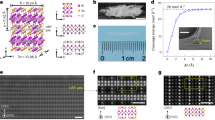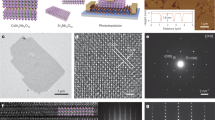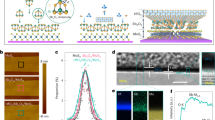Abstract
A range of novel two-dimensional materials have been actively explored for More Moore and More-than-Moore device applications because of their ability to form van der Waals heterostructures with unique electronic properties. However, most of the reported electronic devices exhibit insufficient control of multifunctional operations. Here, we leverage the band-structure alignment properties of narrow-bandgap black phosphorus and large-bandgap molybdenum disulfide to realize vertical heterostructures with an ultrahigh rectifying ratio approaching 106 and on–off ratio up to 107. Furthermore, we design and fabricate tunable multivalue inverters, in which the output logic state and window of the mid-logic can be controlled by specific pairs of channel length and, most importantly, by the electric field, which shifts the band-structure alignment across the heterojunction. Finally, high gains over 150 are achieved in the inverters with optimized device geometries, showing great potential for future logic applications.
This is a preview of subscription content, access via your institution
Access options
Access Nature and 54 other Nature Portfolio journals
Get Nature+, our best-value online-access subscription
$29.99 / 30 days
cancel any time
Subscribe to this journal
Receive 12 print issues and online access
$259.00 per year
only $21.58 per issue
Buy this article
- Purchase on Springer Link
- Instant access to full article PDF
Prices may be subject to local taxes which are calculated during checkout






Similar content being viewed by others
References
Geim, A. & Grigorieva, I. Van der Waals heterostructures. Nature 499, 419–425 (2013).
Li, M. Y., Chen, C. H., Shi, Y. & Li, L. J. Heterostructures based on two-dimensional layered materials and their potential applications. Mater. Today 19, 322–335 (2015).
Britnell, L. et al. Field-effect tunneling transistor based on vertical graphene heterostructures. Science 335, 947–950 (2011).
Yu, W. J. et al. Vertically stacked multi-heterostructures of layered materials for logic transistors and complementary inverters. Nat. Mater. 12, 246–252 (2013).
Moriya, R. et al. Large current modulation in exfoliated-graphene/MoS2/metal vertical heterostructures. Appl. Phys. Lett. 105, 083119 (2014).
Georgiou, T. et al. Vertical field-effect transistor based on graphene–WS2 heterostructures for flexible and transparent electronics. Nat. Nanotech. 8, 100–103 (2013).
Britnell, L. et al. Strong light–matter interactions in heterostructures of atomically thin films. Science 340, 1311–1314 (2013).
Cheng, R. et al. Electroluminescence and photocurrent generation from atomically sharp WSe2/MoS2 heterojunction p–n diodes. Nano. Lett. 14, 5590–5597 (2014).
Furchi, M. M., Pospischil, A., Libisch, F., Burgdörfer, J. & Mueller, T. Photovoltaic effect in an electrically tunable van der Waals heterojunction. Nano. Lett. 14, 4785–4791 (2014).
Lee, G. H., Cui, X. & Kim, P. Atomically thin p–n junctions with van der Waals heterointerfaces. Nat. Nanotech. 9, 676–681 (2014).
Flöry, N. et al. A WSe2/MoSe2 heterostructure photovoltaic device. Appl. Phys. Lett. 107, 123106 (2015).
Roy, T. et al. Dual-gated MoS2/WSe2 van der Waals tunnel diodes and transistors. Acs Nano 9, 2071–2079 (2015).
Withers, F. et al. Light-emitting diodes by band-structure engineering in van der Waals heterostructures. Nat. Mater. 14, 301–306 (2015).
Xue, Y. et al. Scalable production of a few-layer MoS2/WS2 vertical heterojunction array and its application for photodetectors. ACS Nano 2, 10–28 (2015).
Nourbakhsh, A., Zubair, A., Dresselhaus, M. S. & Palacios, T. Transport properties of a MoS2/WSe2 heterojunction transistor and its potential for application. Nano. Lett. 16, 1359–1366 (2016).
Warschauer, D. Electrical and optical properties of crystalline black phosphorus. J. Appl. Phys. 34, 1853–1860 (1963).
Wittig, J. & Matthias, B. Superconducting phosphorus. Science 160, 994–995 (1968).
Asahina, H. & Morita, A. Band structure and optical properties of black phosphorus. J. Phys. C 17, 1839 (1984).
Morita, A. Semiconducting black phosphorus. Appl. Phys. A 39, 227–242 (1986).
Buscema, M. et al. Fast and broadband photoresponse of few-layer black phosphorus field-effect transistors. Nano. Lett. 14, 3347–3352 (2014).
Du, Y., Liu, H., Deng, Y. & Ye, P. D. Device perspective for black phosphorus field-effect transistors: contact resistance, ambipolar behavior, and scaling. ACS Nano 8, 10035–10042 (2014).
Li, L. et al. Black phosphorus field-effect transistors. Nat. Nanotech. 9, 372–377 (2014).
Liu, H. et al. Phosphorene: an unexplored 2D semiconductor with a high hole mobility. ACS Nano 8, 4033–4041 (2014).
Kang, J. et al. Probing out-of-plane charge transport in black phosphorus with graphene-contacted vertical field-effect transistors. Nano. Lett. 16, 2580–2585 (2016).
Mak, K. F., Lee, C., Hone, J., Shan, J. & Heinz, T. F. Atomically thin MoS2: a new direct-gap semiconductor. Phys. Rev. Lett. 105, 136805 (2010).
Yin, Z. et al. Single-layer MoS2 phototransistors. ACS Nano 6, 74–80 (2012).
Das, S., Chen, H.-Y., Penumatcha, A. V. & Appenzeller, J. High performance multilayer MoS2 transistors with scandium contacts. Nano Lett. 13, 100–105 (2012).
Deng, Y. et al. Black phosphorus-monolayer MoS2 van der Waals heterojunction p–n diode. ACS Nano 8, 8292–8299 (2014).
Ye, L., Li, H., Chen, Z. & Xu, J. Near-infrared photodetector based on MoS2/black phosphorus heterojunction. ACS Photon. 3, 692–699 (2016).
Chen, P. et al. Gate tunable MoS2–black phosphorus heterojunction devices. 2D Mater. 2, 034009 (2015).
Radisavljevic, B., Whitwick, M. B. & Kis, A. Integrated circuits and logic operations based on single-layer MoS2 . ACS Nano 5, 9934–9938 (2011).
Wang, H. et al. Integrated circuits based on bilayer MoS2 transistors. Nano Lett. 12, 4674–4680 (2012).
Lin, Y. F. et al. Ambipolar MoTe2 transistors and their applications in logic circuits. Adv. Mater. 26, 3263–3269 (2014).
Tosun, M. et al. High-gain inverters based on WSe2 complementary field-effect transistors. ACS Nano 8, 4948–4953 (2014).
Kim, J. S. et al. Dual gate black phosphorus field effect transistors on glass for NOR logic and organic light emitting diode switching. Nano Lett. 15, 5778–5783 (2015).
Su, Y., Kshirsagar, C. U., Robbins, M. C., Haratipour, N. & Koester, S. J. Symmetric complementary logic inverter using integrated black phosphorus and MoS2 transistors. 2D Mater. 3, 011006 (2015).
Yu, L. et al. High-performance WSe2 complementary metal oxide semiconductor technology and integrated circuits. Nano Lett. 15, 4928–4934 (2015).
Pu, J. et al. Highly flexible and high-performance complementary inverters of large-area transition metal dichalcogenide monolayers. Adv. Mater. 28, 4111–4119 (2016).
Yu, L. et al. Design, modeling and fabrication of CVD grown MoS2 circuits with E-mode FETs for large-area electronics. Nano Lett. 16, 6349–6356 (2016).
Zhao, M. et al. Large-scale chemical assembly of atomically thin transistors and circuits. Nat. Nanotech. 11, 954–959 (2016).
Shim, J. et al. Phosphorene/rhenium disulfide heterojunction-based negative differential resistance device for multi-valued logic. Nat. Commun. 7, 13413 (2016).
Zhan, Y., Liu, Z., Najmaei, S., Ajayan, P. M. & Lou, J. Large-area vapor-phase growth and characterization of MoS2 atomic layers on a SiO2 substrate. Small 8, 966–971 (2012).
Liu, H., Neal, A. T. & Ye, P. D. Channel length scaling of MoS2 MOSFETs. ACS Nano 6, 8563–8569 (2012).
Acknowledgements
The authors thank L. Li, S. Li and X. Wang for helpful discussions and technical support, the staff in ‘Wuhan National High Magnetic Field Center’ for technical support during low-temperature electrical measurements, the staff at the ‘Center of Micro-fabrication and Characterization of Wuhan National Laboratory for Optoelectronics’ and ‘Huazhong University of Science and Technology Analytical and Testing Center’ for support with electron-beam lithography, electron-beam evaporation and Raman measurements. This project is supported by the National Natural Science Foundation of China (grants 61574066, 61390504 and 11404118).
Author information
Authors and Affiliations
Contributions
Y.W. conceived the project. M.H. transferred the heterostructures and fabricated the devices. M.H. and S.L. performed optical characterizations and electrical measurements. M.H., X.L. and Y.W. analysed the data. Z.Z. grew the CVD MoS2 and X.X. grew the high-κ dielectric layers. M.H. and Y.W. co-wrote the paper. All authors contributed to discussions about the manuscript.
Corresponding author
Ethics declarations
Competing interests
The authors declare no competing financial interests.
Supplementary information
Supplementary information
Supplementary information (PDF 1906 kb)
Rights and permissions
About this article
Cite this article
Huang, M., Li, S., Zhang, Z. et al. Multifunctional high-performance van der Waals heterostructures. Nature Nanotech 12, 1148–1154 (2017). https://doi.org/10.1038/nnano.2017.208
Received:
Accepted:
Published:
Issue Date:
DOI: https://doi.org/10.1038/nnano.2017.208
This article is cited by
-
Steep-slope vertical-transport transistors built from sub-5 nm Thin van der Waals heterostructures
Nature Communications (2024)
-
Homojunction-loaded inverters based on self-biased molybdenum disulfide transistors for sub-picowatt computing
Nature Electronics (2024)
-
Charge transfer mechanism for realization of double negative differential transconductance
npj 2D Materials and Applications (2024)
-
A reconfigurable binary/ternary logic conversion-in-memory based on drain-aligned floating-gate heterojunction transistors
Nature Communications (2023)
-
How to build good inverters from nanomaterial-based transistors
Nano Research (2023)



